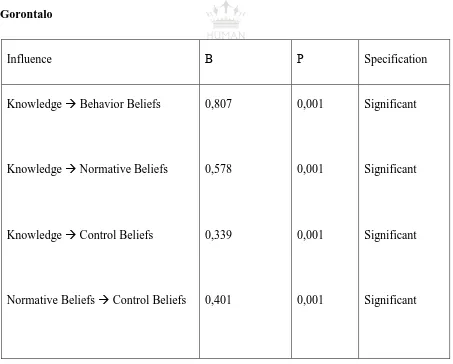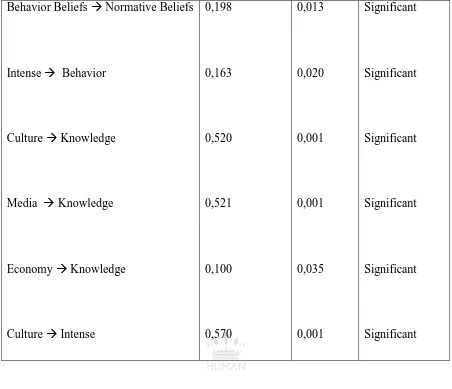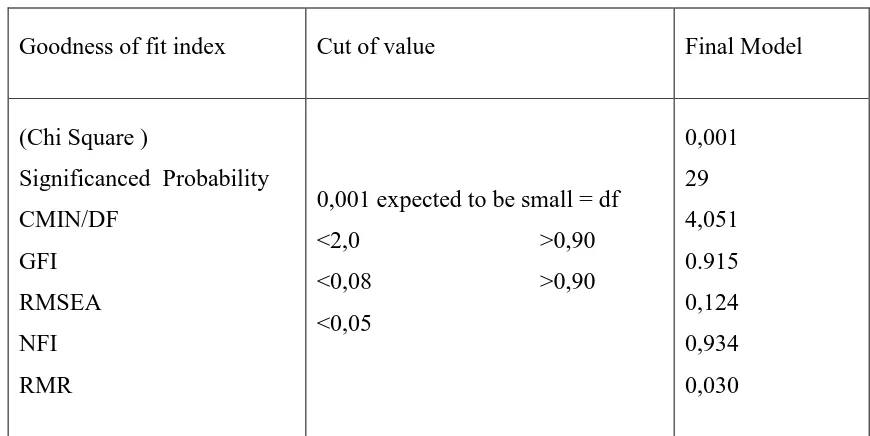Research Article
June 2017 Vol.:9, Issue:3
© All rights are reserved by Irwan et al.
The Model of Risk Behavior at the Rise of HIV and AIDS in
Adolescent in Gorontalo Province
www.ijppr.humanjournals.com
Keywords: Teenagers, gender, HIV and AIDS. ABSTRACT
The aim of this research is to develop a prevention model of
risk behavior of HIV and AIDS in adolescent in Gorontalo City.
The Method of this study was analytic observational study with
cross-sectional study design. The Samples of 200 students were
obtained through purposive random sampling.The research
result showed that the test of construct variable validity towards
latent variable such as teenager parents income (X1), culture
(X2), religious obedience (X3), and the role of mass media
(X4), teenager knowledge (Y1), behavior beliefs (Y2),
normative beliefs (Y3), control beliefs (Y4), intension (Y5) and
behavior risk (Y6) described the validation results which were
all data below p<0.05. In person correlation, we can be stated
that valid data unless the data have significance value < 0.05.
The model of behavior risks of AIDS can be emphasized on
gender which was one of most important factor to prevent HIV
and AIDS.
Irwan*, Ekawaty Prasetya
*Department of Public Health, Faculty of Sport and
Health, State University of Gorontalo, Gorontalo.
Submission: 2 June 2017
Accepted: 10 June 2017
INTRODUCTION
In 2008, the national family planning coordinating board (BKKBN) in Indonesia stated that 63% of teenagers on junior and senior high school age on 33 provinces of Indonesia have ever done sex intercourse and 21% of teenagers have ever done abortion. This percentage increased from the same survey in 2006 which the number range was around 45-44% (Brent, 1995).
The research which has been done in Jakarta, Bandung, Surabaya and Medan by taking sample of aged teenagers between 15 and 24 years old, the balanced male and female comparison, 50% of respondent having sexually active and 50% of not sexually active. The previous research gave interesting perspective about the teenagers want to know how to prevent HIV and AIDS by getting information about sex education including the prevention of sexual diseases. Otherwise, some teenagers lack information about that till now. They want to know how to use contraception tool, the process of pregnancy occurs. As the result, only 5% of respondents gaining knowledge from their parents and only received information from their friends and blue film (Albarracin, 2004).
In 2002-2003, the other survey showed that adult male sexual behavior in 10 provinces in Indonesia described 16% respondent of 3851 respondents which did not do sex intercourse and 32.8% respondent who had sex with just one couple. The remaining 51% are active in sexual intercourse with more females. In fact, there were 18% of respondents who actively had sex with 9 people in the last year (Brown, 2006).
In Gorontalo Province based on population census in 2010, the number of adolescents reported 1257 lives or 11.3% of the population. The number of HIV and AIDS cases reported by the Gorontalo Provincial AIDS Control Commission in 2001 to 2011 was 80 cases, of which there were 10 men and women of youth who were infected with HIV and AIDS.
MATERIALS AND METHODS
The type of research used is observational research. The population is all teenagers of SMU, SMK and MA students throughout Gorontalo City who are at least 17 years old at the time of the interview. The sample is a student of SMU, SMK and MA which is at least 17 years old at the time of the research. In this research, there are six endogenous variables, namely knowledge variable, behavior beliefs variable, normative beliefs variable, beliefs variable, intensity variable and risk behavior variable.
RESULTS
The result of modeling of behavior risk in an adolescent is obtained result that beliefs variable have no significant effect to intensi and behavior variable. In adolescent economic, culture and mass media variables significantly influence the level of adolescent knowledge, religious compliance variables significantly influence the intention. This can be seen in the following figure and table.
Table 1. The relationship between Significant Variables of Young Behavior Model in
Gorontalo
Influence Β Ρ Specification
Knowledge Behavior Beliefs
Knowledge Normative Beliefs
Knowledge Control Beliefs
Normative Beliefs Control Beliefs
0,807
0,578
0,339
0,401
0,001
0,001
0,001
0,001
Significant
Significant
Significant
Behavior Beliefs Normative Beliefs
Intense Behavior
Culture Knowledge
Media Knowledge
Economy Knowledge
Culture Intense
0,198
0,163
0,520
0,521
0,100
0,570
0,013
0,020
0,001
0,001
0,035
0,001
Significant
Significant
Significant
Significant
Significant
Significant
Fig. 1. Pathway analysis of the model of HIV/AIDS risk Behavior in Adolescents in
Gorontalo City.
MODEL EVALUATION
the actual or actual input with the prediction of the proposed model. The fitness index of the Goodness of fit model is used, among others, by looking at the chi square numbers and the probability values of significance. Model test results can be seen in the following table:
Table 2. Test results model based on Goodness of Fit
Goodness of fit index Cut of value Final Model
(Chi Square ) Gorontalo can be said fit when looking at some of the above criteria, for example, Chi-square value of 0.001 than expected small, GFI value of 0.915 from standard> 0.90, NFI value of 0.934 from the standard of> 0.90 and the standard goodness of fit based on the RMR value of 0.030.
DISCUSSION
The Influence of Culture, Income of Parents and Mass Media on Youth Knowledge
In the theory of Plan Behavior (TPB) individual characteristics are factors that influence beliefs (behavior beliefs, normative beliefs and control beliefs) characteristics individual consists of three categories, namely personal categories that include general attitudes, personal traits, values, emotion and intelligence. The second category is the social aspect such as age, sex, income and religion. The third category is the aspect of information that includes experience and media exposure. (Cici S. Hasan).
The Influence of Religious Compliance to Intentions and Behavior in Adolescents
Religious adherence significantly influences the intention of adolescents, furthermore, the intention of adolescent girls significantly influences HIV / AIDS risk behavior.
The results of this study are in line with research conducted by O.Wusu who examines religion, religiosity and risk behavior of juvenile sexual health in Lagos Metropolis, Nigeria survey results collected between December 2009 and February 2010 in the Metropolitan city of Lagos. The results revealed that religious affiliation was not significantly related to sexual relations in boys (p> 0.05), religiosity was significantly related (p <0.05) to some sexual partners in the analysis among women. The study concludes that religious affiliation does not play an important role in fighting risk sexual behavior in adolescent boys but religiosity can be quite effective in preventing risky behavior in women groups.
Knowledge Effects on Behavioral Beliefs, Normative Beliefs and Control Beliefs
Result of research of adolescent knowledge has significant effect to behavior beliefs and normative beliefs. The result of this research indicates that adolescent belief to the consequence if doing risk behavior influenced by level of knowledge of adolescent about HIV and AIDS equal to 0,807. As well as the adolescent level of knowledge about HIV and AIDS, adolescents are increasingly convinced that the impact of such risk behaviors can lead to HIV and AIDS.
influenced by adolescent knowledge about the impact of such behavior that will transmit HIV infection and AIDS disease as outcome from the behavior.
Effects of Behavior Beliefs, Normative Beliefs and Control Beliefs on Intentions of
Youth
The results of modeling in adolescents show that beliefs (behavior beliefs, normative beliefs and control beliefs) have no significant or insignificant effect on the intention.
The results of this study are not in accordance with the concept of Theory of Plan Behavior (TPB) which states that the intention is formed by some beliefs (beliefs) before the intention directly affect the behavior. The results of this study are in line with research conducted by Lin, Huey-Ling, et al. (2006). The result of the relationship analysis between the variables showed an insignificant relationship between belief and intention to perform sexual behavior. This relationship suggests that adolescent beliefs may often conflict with their intention to engage in sexual behavior. These findings raise questions about the strength of adolescent beliefs compared to the forces of the social environment and norms that can foster sexual intentions. So other variables are of particular concern to the social context and cultural factors (eg, peer pressure, school environment, and family factors), by examining the factors that influence sexual beliefs and sexual intentions, we may be able to identify certain aspects of teenage sexual behavior.
Influence of Intent on Youth Behavior
The results showed that the intention of adolescents has a positive and significant impact on risk behavior. Ajzen interpreted the intention as a behavioral disposition that until the right time and opportunity will be manifested in the form of action. In line with that definition Fedman (1995) states intentions are individual plans or resolutions to carry out behaviors that are appropriate to their attitudes. Intention is also defined as an internal declaration to /do something.
similar to the results of a study conducted by Nahom et al., (2001) study that found intentions to engage in related sexual behavior to actually engage in sexual behavior.
CONCLUSION
The risk behavior of HIV and AIDS in adolescents in Gorontalo city is directly affected by intensi variables. Religious adherence in adolescent girls significantly influences intense.
REFERENCES
1. Ajzen I. Ishbein M. Attitudes, Personality and Behaviour. Milton-Keynes, England: open University Press & Chicago, IL.Dorsey press. 1998.
2. Ajzen I. Attitudes, Personality Organizational Behaviour and Human Decision Processes. Behaviour, second Edition, New York: Milton Keynes OUP. 2006.
3. Albarracin D. et.al. Influences of social power and normative support on condom use decisions: a research synthesis: J. AIDS Care. 2004; 16(6); 700-723.
4. Behrman. Labor Markets In Developing Countries, Handbook of Labor Economics, in O. Ashenfelter & D. Card (ed.), Handbook of Labor Economics. 1st ed. 2859-2939. Elsevier; 1999. http://onlinelibrary.wiley.com. 5. Brent B. The Effect of Religion on Adolescent Delinquency Revisited. J. Resc in Crime and Delinquency. 1995; 32; 446–466.
6. Berrigan D. et.al. Patterns of Health Behaviours in US Adults. Preventive Medicine. 2003; 36; 615-623. 7. Brown et.al. Sexi Media Matter, Exposure to Sexual Content in Music, Movie, Television and Magazine Predict Black and White Adolescend Sexual Behavior. J. Pediatrick. 2006; 117; 1018-1027.
8. Brown et.al. Sexual Tens, Sexual Media: Investigating Media‘S Influence on Adolescend Sexuality. J. Lawrence Erlbaun. 2002; 1-24.
9. Fishbein M. Ajzen I. Belief, Attitude, Intention, and Behaviour: And Introduction to Theory and Research. California: Addison-Wesley. 1991.
10. Friedman S. HIV Prevalence, Risk Behaviours, and High-Risk Sexual and Injection Networks Among Young Women Injectors Who Have Sex With Women. J. Public Health. 2003; 93(6); 902–906.
11. Huebner A. & Garrod, A. Equilibration and the Learning Paradox. Human Development. 1991; 34; 261-272.


